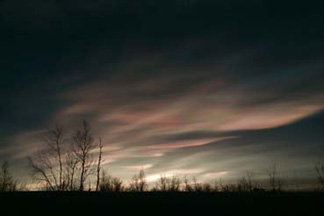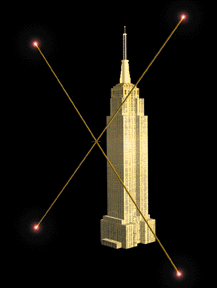
The iridescent polar stratospheric clouds drifting 20 kilometers
over the Arctic are lasting longer and furthering the loss of ozone.
NASA
| Geotimes Home | Calendar | Classifieds | Subscribe | Advertise |
| Geotimes
Published by the American Geological Institute |
Newsmagazine
of the Earth Sciences
July 2000 |
Clouds in
cahoots with ozone thieves
| Polar stratospheric, mother-of-pearl clouds are the guilty culprits of ozone loss as they waver in the twilight over the Arctic during late winter and early spring, says Michael J.Kurylo of NASA’s upper atmospheric research program in Washington. On May 30, Kurylo and colleagues announced at the American Geophysical Union meeting their surprise at finding that the loss of ozone in the northern polar region is linked to climate change. Although radiated energy reflected from the clouds warms Earth’s surface, it effectively cools the stratosphere and allows the clouds a longer lifetime of perpetrating chlorofluorocarbon-based inactive chlorine (Cl-2) compounds. These compounds convert into the ozone-destroying reactive chlorine (Cl) compounds. The persisting clouds also precipitate out nitric acid, leaving the chlorine without the mitigating guard of nitrogen. | 
The iridescent polar stratospheric clouds drifting 20 kilometers over the Arctic are lasting longer and furthering the loss of ozone. NASA |
Christina Reed
Corrupting coral
Controlled experiments of coral reef ecosystems have revealed that rising carbon dioxide in sea water can lead to intolerable levels of carbonate ions for reef growth. Christopher Langdon of the Lamont Doherty Earth Observatory led research at ColumbiaUniversity’s Biosphere 2 Center in Tucson, Ariz., to determine the effect of changing ocean chemistry on coral reef calcification. Langdon expects that continuing industrialization and burning of fossil fuels will reduce the carbonate ion concentration in surface waters by 40 percent over the next 65 years. The findings were published in the June issue of Global Biogeochemical Cycles.
Laura Wright
New sights
on solar storms
| As a solar maximum approaches and solar storms are on the rise, understanding solar wind and its interaction with Earth’s magnetic field, or magnetosphere, is crucial, said scientists on May 31 at the spring meeting of the American Geophysical Union. Two months after the launch of the Imager for Magnetopause-to-Aurora Global Exploration (IMAGE) satellite, researchers viewed global images of the magnetosphere where tenuous solar and terrestrial plasmas interact. Often solar storms in this region can damage satellites and cause communication blackouts. The new global images of Earth’s magnetosphere will help to refine the existing model for predicting space weather, thus limiting future blackouts. For more information visit: http://image.gsfc.nasa.gov. | 
|
The spin-plane dipole antennas along IMAGE’s X and Y axes stretch 1,647 feet tip-to-tip, 182 feet longer than the height of the Empire State Building.The long antennas allow the Radio Plasma Imager on board to generate very low frequency radio waves and receive the resulting echoes. NASA. |
Bridget Mulvey
 |
Geotimes Home | AGI Home | Information Services | Geoscience Education | Public Policy | Programs | Publications | Careers |